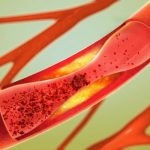 Deep vein thrombosis (DVT) is when one or more veins, usually in the legs, form a clot. An estimated two million Americans annually are affected by DVT, according to the American Heart Association. To raise public awareness about this condition, Deep Vein Thrombosis Month is held every year in March.
Deep vein thrombosis (DVT) is when one or more veins, usually in the legs, form a clot. An estimated two million Americans annually are affected by DVT, according to the American Heart Association. To raise public awareness about this condition, Deep Vein Thrombosis Month is held every year in March.
According to a national survey conducted by the American Heart Association, an estimated 74 percent of Americans are unaware of this condition.
Advertisement
We at Bel Marra Health have compiled a list of articles to help you understand DVT, its complications, and what you can do about it.
Blood clots in legs (deep vein thrombosis): Symptoms, causes, and treatment
A blood clot in the leg—known as deep vein thrombosis—can pose serious health risks. Deep vein thrombosis occurs deep within the body and the blood clot is often gelatinous and solid. Deep vein thrombosis commonly occurs in the lower leg or thigh but can occur elsewhere in the body. Your doctor may refer to a blood clot in the leg as thromboembolism, post-thrombotic syndrome, or post-phlebitic syndrome.
Complications can arise in deep vein thrombosis cases when the blood clot dislodges itself, allowing it to travel through the body. If the blood clot makes its way to the lungs, it is known as a pulmonary embolism, which is a life-threatening condition. Deep vein thrombosis can also contribute to lasting problems such as muscle aches, swelling, and color changes of the skin.
Annually in the U.S., an estimated 350,000 to 600,000 individuals will develop a blood clot in the leg.
Below you will learn more about the causes, symptoms, and treatment for a blood clot in the leg and how you can further reduce your risk of developing one. Continue reading….
 Rheumatoid arthritis increases deep vein thrombosis (blood clots in legs) and blood clot in lungs risk, study
Rheumatoid arthritis increases deep vein thrombosis (blood clots in legs) and blood clot in lungs risk, study
Rheumatoid arthritis increases the risk of deep vein thrombosis (blood clots in legs) and blood clots in lungs, according to research. The findings revealed that individuals with rheumatoid arthritis – an inflammatory type of arthritis – have triple the risk of developing deep vein thrombosis and double the risk of pulmonary thromboembolism (blood clotting in the lungs), compared to individuals without rheumatoid arthritis.
Dr. Tore Kvien, editor-in-chief of the journal Annals of the Rheumatic Diseases and head of rheumatology at Diakonhjemmet Hospital in Oslo, Norway, said, “I would call this a moderate increased risk.”
“This study is consistent with what our study and other published papers found,” added Dr. Seoyoung Kim, assistant professor of medicine at Brigham and Women’s Hospital and Harvard Medical School in Boston. Dr. Kim’s team also found a similar association in their study. Continue reading…
 Thrombophlebitis (phlebitis) can cause superficial thrombophlebitis or deep vein thrombosis
Thrombophlebitis (phlebitis) can cause superficial thrombophlebitis or deep vein thrombosis
Thrombophlebitis (phlebitis) can cause superficial thrombophlebitis or deep vein thrombosis. Thrombophlebitis is when a blood clot occurs in one or more veins within the legs. Although rare, thrombophlebitis can occur in the arms or neck as well.
Veins affected by thrombophlebitis are typically close to the skin’s surface, which causes superficial thrombophlebitis or within the depths of the muscle, which causes deep vein thrombosis.
Causes of thrombophlebitis range from surgery and trauma to prolonged inactivity. Superficial thrombophlebitis commonly occurs in those with varicose veins.
A blood clot can escalate into a serious health problem; the clot can become dislodged and travel to the lungs, which leads to a pulmonary embolism. A blood clot can be treated with blood-thinning medications. Continue reading…
 Varicose Veins Linked with Higher Risk of Deep Venous Thrombosis
Varicose Veins Linked with Higher Risk of Deep Venous Thrombosis
Varicose veins are swollen and twisted veins that could be linked to a higher risk of developing deep venous thrombosis. The new research that explored this link claimed that the risk of developing dangerous blood clots increases five times for those suffering from varicose veins.
What Is Deep Venous Thrombosis?
Deep venous thrombosis is a condition where clots develop in the veins of legs and travel through these veins up to the heart and lungs. This can cause a serious threat to life as the clot can obstruct blood flow and can cause pulmonary embolisms (clots in the lungs) or lead to the development of peripheral artery disease, a condition where the arteries of the limbs become narrow.
Most often, the symptoms of deep venous thrombosis are unnoticed. The noticeable symptoms include leg pain, skin discoloration, and a warm feeling in the affected leg. However, a new study suggests that varicose veins also have a link to the condition. Continue reading…
 Asthma patients face higher risk of pulmonary embolism, deep vein thrombosis
Asthma patients face higher risk of pulmonary embolism, deep vein thrombosis
Advertisement
Asthma patients face higher risk of pulmonary embolism and deep vein thrombosis. The findings were published in the European Respiratory Journal. Researchers looked at moderate to severe asthma sufferers and their risk of pulmonary embolism and deep vein thrombosis.
Pulmonary embolism is a condition in which the main artery of the lung or the bronchi becomes blocked as a result of deep vein thrombosis, which develops when a blood clot moves towards the lungs.
The study looked at 648 asthma patients aged 18 to 88. History of asthma was examined, along with medication use and any previous diagnosis of pulmonary embolism and deep vein thrombosis. Results from the asthma patients were compared to individuals without asthma. Continue reading…
